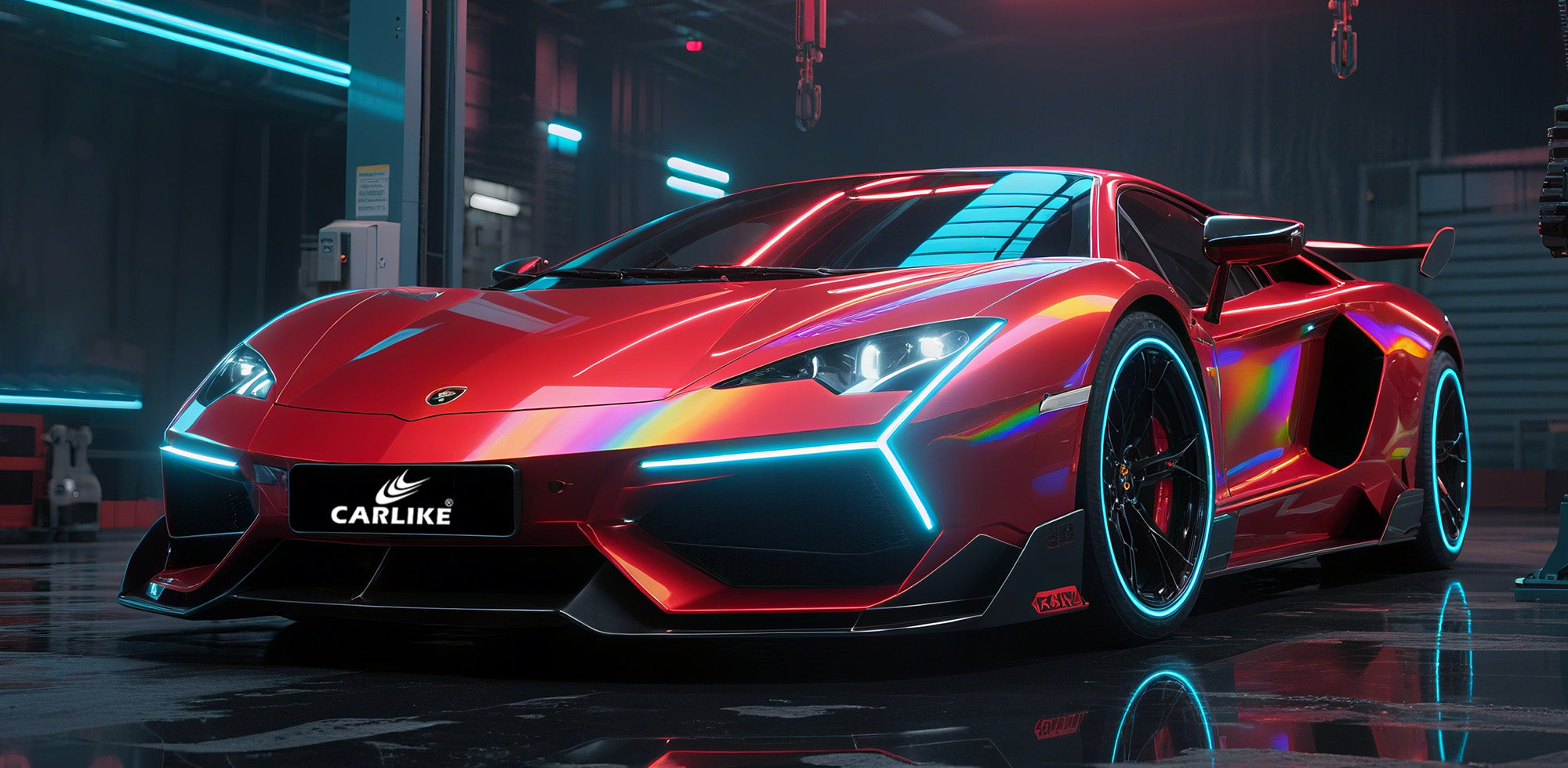What is car head light tint film?
Car headlight tint film, a specialized and innovative accessory, goes beyond the conventional function of protecting vehicle headlights. Beyond its protective role, this thin, adhesive film opens up avenues for personal expression and customization in the automotive world.
When applied directly to the surface of a car's headlights, the tint film serves as a versatile canvas for car owners to showcase their individual style preferences. The customization possibilities are vast, ranging from subtle and sophisticated tints to bold and eye-catching colors. This transformative aspect of headlight tinting allows drivers to make a unique statement and infuse their vehicles with a touch of personality.
The availability of tint films in various shades and finishes adds to the allure of this accessory. Car owners can choose from a spectrum of colors, including smoked, matte, or even iridescent finishes, to create a look that seamlessly integrates with the overall aesthetic of their vehicle. Whether aiming for a stealthy, understated appearance or a vibrant, attention-grabbing presence, the diverse range of tint options empowers car enthusiasts to tailor their vehicles according to their tastes.
Furthermore, the application of headlight tint film is a relatively simple and non-intrusive process. This means that car owners can experiment with different styles without making permanent modifications to their vehicles. The ease of application and removal allows for flexibility, letting individuals adapt their vehicle's appearance to suit changing trends or personal preferences over time.
What are the uses of car light film?
Automotive headlight tint film serves multiple purposes, contributing to both the aesthetic appeal and functional aspects of a vehicle. Here are some key purposes and benefits of using car headlight tint film:
1. Protection from Environmental Elements: One of the primary purposes of headlight tint film is to act as a protective layer against various environmental elements. It shields headlights from road debris, stone chips, bug splatter, and harsh weather conditions, helping to prevent scratches, pitting, and discoloration over time.
2. UV Ray Blocking: Tint films are designed to block harmful ultraviolet (UV) rays from the sun. Continuous exposure to UV radiation can lead to the deterioration of headlights, causing them to fade and become cloudy. Headlight tint film helps mitigate this by acting as a barrier against UV rays, preserving the clarity and longevity of the headlights.
3. Enhanced Aesthetics: Beyond protection, car owners often use headlight tint films as a means of enhancing the visual aesthetics of their vehicles. The films are available in various shades and finishes, allowing for customization to achieve a desired look. Whether opting for a sleek, smoked appearance or a more vibrant and stylized finish, headlight tinting can significantly contribute to a vehicle's overall visual appeal.
4. Customization and Personalization: Car headlight tint films offer an opportunity for drivers to personalize their vehicles. With a wide range of colors, shades, and finishes available, individuals can tailor their headlights to match their unique style preferences and make a distinctive statement on the road.




What types of car light films are there at CARIKE?
Car headlight tint films come in various types, each offering unique features and aesthetic enhancements. Here's an overview of four different types: normal, chameleon, glitter, and 3D effect.
1. Normal Tint Film: Normal tint films are characterized by a consistent and uniform color or shade. These films are often chosen for their simplicity and subtlety, providing a classic and clean look to the vehicle's headlights. normal tint films are available in a wide range of colors, allowing car owners to select an option that complements the overall design and color scheme of their vehicles. The primary purpose of normal tint film is to add a touch of style without being overly flashy, making it a popular choice for those seeking a more understated appearance.

2. Chameleon Tint Film: Chameleon tint films are known for their color-shifting properties, creating a dynamic and eye-catching effect. These films exhibit different colors depending on the angle and lighting conditions. A chameleon tint film might shift between various hues, adding an element of surprise and uniqueness to the vehicle's headlights. This type of tint film is often chosen by car enthusiasts who want to make a bold statement and draw attention to their vehicles. The color-changing effect of chameleon tint can be especially captivating during daytime and under varying lighting scenarios.

3. Glitter Tint Film: Glitter tint films are designed to infuse a touch of glamour and sparkle into vehicle headlights. These films incorporate reflective particles that produce a glittering or shimmering effect when exposed to light. The reflective elements in the tint film not only add a visual appeal but also contribute to increased visibility, especially during nighttime driving. Car enthusiasts who desire a head-turning and dazzling appearance for their vehicles often opt for glitter tint films. This type of tint film allows for a unique and attention-grabbing customization, combining style with a hint of sparkle.

4. 3D Effect Tint Film: 3D effect tint films utilize intricate patterns and designs to create a three-dimensional visual impact. These films often incorporate textures, holographic elements, or embossed patterns that give the appearance of depth and dimension. The 3D effect can add a level of sophistication and artistic flair to the vehicle's headlights, making them stand out with a visually engaging and unique look. Car owners who appreciate avant-garde and artistic modifications often opt for 3D effect tint films to express their individuality.
In summary, whether choosing a standard, chameleon, reflective, or 3D effect tint film, car owners have a plethora of options to elevate the aesthetics of their vehicles. Each type offers a distinct visual appeal, allowing for personalization and customization in the realm of automotive styling.
How to install car light film yourself at home?
DIY Installation Guide:Offering a straightforward and user-friendly do-it-yourself (DIY) installation guide is crucial for assisting car owners in seamlessly replacing or installing automotive headlight tint films at home. Follow these simple steps to achieve a successful DIY installation:
1. Gather the Necessary Tools: Ensure you have all the required tools for the installation, including the tint film, a heat gun or hairdryer, a squeegee, a utility knife, and a spray bottle filled with a mild soap and water solution.
2. Clean the Headlights: Thoroughly clean the headlights to remove any dirt, debris, or residue. Use a gentle cleanser and a microfiber cloth to ensure a smooth surface for the tint film application.
3. Measure and Cut the Film: Carefully measure the dimensions of the headlights and cut the tint film accordingly. Leave a slight overhang to allow for adjustments during the installation process.
4. Wet Application: Mist the surface of the headlights with the soap and water solution. This helps create a slippery surface for positioning the tint film and prevents it from sticking prematurely.
5. Position and Smooth: Place the cut tint film onto the wet surface, adjusting it to align with the headlights' contours. Use the squeegee to smooth out any air bubbles or wrinkles, working from the center towards the edges.
6. Heat Shaping: Use the heat gun or hairdryer to gently heat the tint film. This makes it more pliable, allowing you to shape it to the curves of the headlights. Continue smoothing out any imperfections as you apply heat.
7. Trim Excess Film: Trim the excess film around the edges using a sharp utility knife. Take your time and follow the contours of the headlights for a precise fit.
8. Final Inspection: After the installation, carefully inspect the tint film for any remaining bubbles, wrinkles, or imperfections. If necessary, use the heat gun and squeegee to make final adjustments.
9. Curing Time: Allow the tint film to cure for the recommended time as per the manufacturer's instructions. This ensures proper adhesion and longevity of the installation.
By following these simple steps, car owners can successfully and confidently complete the DIY installation of headlight tint films at home, achieving a professional-looking result while enjoying the satisfaction of a hands-on automotive customization project.
After seeing this, you may be interested in the following
FAQ for Car Headlight Tinting?
Q: What is car headlight tinting?
A: Car headlight tinting involves applying a thin film to the surface of the headlights to enhance aesthetics, provide protection, and sometimes improve visibility.
Q: Is headlight tinting legal?
A: The legality of headlight tinting varies by region. It's crucial to check local regulations as some places have restrictions on the level of tint allowed.
Q: How does headlight tint film protect headlights?
A: Headlight tint film acts as a protective barrier against road debris, UV rays, and environmental elements, preventing scratches, discoloration, and damage.
Q: Can I remove headlight tint film once it's applied?
A: Yes, most headlight tint films are designed to be removable. Applying heat and using the right tools can make the removal process easier.
Q: Does tinting affect the brightness of headlights?
A: It depends on the tint level. Lighter tints may have minimal impact, while darker tints can reduce light output. Check local regulations to ensure compliance with brightness standards.
Final Words
Ultimately, the longevity and effectiveness of headlight tinting depend on factors such as the quality of the film, adherence to installation instructions, and environmental conditions. Regular maintenance and adherence to recommended care practices contribute to prolonged aesthetic appeal and protection.








